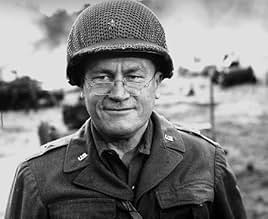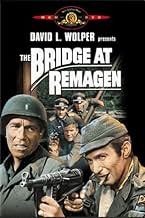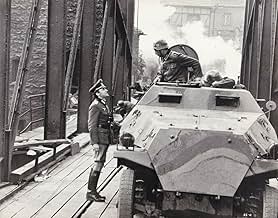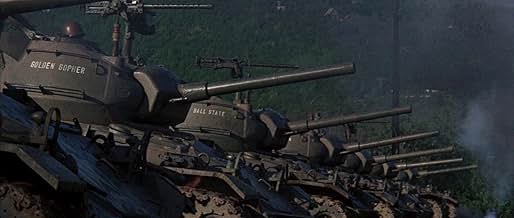IMDb रेटिंग
6.7/10
11 हज़ार
आपकी रेटिंग
अपनी भाषा में प्लॉट जोड़ेंAs the Allied armies close in, the Germans decide to blow up the last Rhine bridge, trapping their own men on the wrong side. But will it happen?As the Allied armies close in, the Germans decide to blow up the last Rhine bridge, trapping their own men on the wrong side. But will it happen?As the Allied armies close in, the Germans decide to blow up the last Rhine bridge, trapping their own men on the wrong side. But will it happen?
- निर्देशक
- लेखक
- स्टार
Peter van Eyck
- Gen. Von Brock
- (as Peter Van Eyck)
Anna Gaël
- French Girl
- (as Anna Gael)
Vít Olmer
- Lt. Zimring
- (as Vit Olmer)
फ़ीचर्ड समीक्षाएं
Spectacular and exciting warlike movie based on famous event about the Bridge at Remagen . This Blockbuster is one of the biggest war films ever made. It's a magnificent film, recreating the known offensive by Allied army on the German front during 1945 .What happened during those desperate days that could have changed the course of war is now history . It's well recreated by John Guillermin for United Artists, with Technicolor cinematography by Stanley Cortez. The producer, David L Wolper was well-qualified for his job as he made documentary as ¨D-Day ,6 June, 1944¨ and produced ¨The Devil's brigade¨ , among others. Stirring images accompanied with roaring battle noises it quite possible for the sound effects you heard today to be as realistic as those he heard when was listening to them whining overhead.Furthermore , it packs a moving musical score in military parade style composed by the master Elmer Berstein. The making was a logistical problem as almost that of setting up a campaign and putting a film together under any circumstances was very difficult because working under pretty bad conditions. So this whole film was put together, photographed and edited, scored and prepared for release in a matter of about various months. After a daring escape from Czechoslovakia where was shot at Davle and Most , filming was resumed near Hamburg, Germany and closely the Pope's summer house, Castelgondolfo, Italy.
The film is based on real events, though the characters are fictitious, those are the following : The Ludendorff Bridge at Remagen—the last standing on the Rhine was captured by soldiers of the U.S. 9th Armored Division on 7 March 1945, during Operation Lumberjack. Although German engineers had mined the bridge before the American approach, the fuses had been cut by two Polish engineers forcibly conscripted to the Wehrmacht. On 7 March 1945, soldiers of the 27th Armored Infantry Battalion, led by Lieutenant Karl H. Timmermann,(at the movie Phil Hartman well played by George Segal) approached the bridge, and found it standing. The first American soldier across the bridge was Sergeant Alex Drabik (at the film bears similar role played by Ben Gazzara as corrupt sergeant Angelo) ; Lt. Timmermann was the first officer across. Although the bridge's capture is sometimes regarded as the "Miracle of Remagen" in U.S. histories, historians debate the strategic importance of the capture of the bridge at Remagen. General Eisenhower ( in the movie a similar character is played by E.G. Marshall as General Shinner) said that "the bridge is worth its weight in gold". However, few U.S. units were able to operate east of the Rhine ahead of the main crossings in the south, under Gens. Patton and Bradley, and in the north, under Gen. Montgomery . Ultimately, only a limited number of troops were able to cross the Rhine before the bridge's collapse. However, the psychological advantage of having crossed the Rhine in force and in pursuit of the retreating Wehrmacht, improved Allied morale while communicating disaster to the retreating Germans. Hitler ordered a flying courts-martial that condemned five officers to death. Captain Bratge, who was in American hands, was sentenced in absentia while the other four (Majors Scheller, Kraft, and Strobel, and Captain Peters , respectively played by Robert Vaughan as Major Kruger and Hans Chritian Blech as Captain Carl Schmidt ) were subsequently executed . Soldiers from the U.S. Army Corps of Engineers worked long hours to stabilize and repair the bridge . However, despite the best U.S. efforts, on 17 March 1945, ten days after its capture, the Bridge at Remagen succumbed to the cumulative damage from German bombing and collapsed, killing twenty-eight soldiers of the Army Corps of Engineers. However, because the pontoon bridges and other secured crossing points had supplanted the bridge, its loss was neither tactically nor strategically significant. Still, the Ludendorff Bridge remained important as the first point at which Allies crossed the Rhine.
The film is based on real events, though the characters are fictitious, those are the following : The Ludendorff Bridge at Remagen—the last standing on the Rhine was captured by soldiers of the U.S. 9th Armored Division on 7 March 1945, during Operation Lumberjack. Although German engineers had mined the bridge before the American approach, the fuses had been cut by two Polish engineers forcibly conscripted to the Wehrmacht. On 7 March 1945, soldiers of the 27th Armored Infantry Battalion, led by Lieutenant Karl H. Timmermann,(at the movie Phil Hartman well played by George Segal) approached the bridge, and found it standing. The first American soldier across the bridge was Sergeant Alex Drabik (at the film bears similar role played by Ben Gazzara as corrupt sergeant Angelo) ; Lt. Timmermann was the first officer across. Although the bridge's capture is sometimes regarded as the "Miracle of Remagen" in U.S. histories, historians debate the strategic importance of the capture of the bridge at Remagen. General Eisenhower ( in the movie a similar character is played by E.G. Marshall as General Shinner) said that "the bridge is worth its weight in gold". However, few U.S. units were able to operate east of the Rhine ahead of the main crossings in the south, under Gens. Patton and Bradley, and in the north, under Gen. Montgomery . Ultimately, only a limited number of troops were able to cross the Rhine before the bridge's collapse. However, the psychological advantage of having crossed the Rhine in force and in pursuit of the retreating Wehrmacht, improved Allied morale while communicating disaster to the retreating Germans. Hitler ordered a flying courts-martial that condemned five officers to death. Captain Bratge, who was in American hands, was sentenced in absentia while the other four (Majors Scheller, Kraft, and Strobel, and Captain Peters , respectively played by Robert Vaughan as Major Kruger and Hans Chritian Blech as Captain Carl Schmidt ) were subsequently executed . Soldiers from the U.S. Army Corps of Engineers worked long hours to stabilize and repair the bridge . However, despite the best U.S. efforts, on 17 March 1945, ten days after its capture, the Bridge at Remagen succumbed to the cumulative damage from German bombing and collapsed, killing twenty-eight soldiers of the Army Corps of Engineers. However, because the pontoon bridges and other secured crossing points had supplanted the bridge, its loss was neither tactically nor strategically significant. Still, the Ludendorff Bridge remained important as the first point at which Allies crossed the Rhine.
I remember seeing this movie in the late 1970s and liked it a lot and still watch it every time it's broadcast not infrequently on television . I was very disappointed that it didn't make the recent list of Channel 4 's 100 GREATEST WAR MOVIES list
What I like about THE BRIDGE AT REMAGEN is its cynical edge . You see in these type of movies the Yanks are invincible knights in shining armour while the Jerries are invariably goose stepping Nazi dumbkopfs and while there is an element to Uncle Sam winning the war single handed it's nowhere enough to drag the movie into mediocrity . When I say " cynical " the screenplay is very even handed - The Americans loot from the bodies of the dead and come close to fragging a senior officer at one point while German civilians bleat that they're not Nazis seconds after taking down prized portraits of Adolph Hitler
Of course much of the cynicism is helped because of the period setting . It's only a few weeks from the final end of the war in Europe and everyone knows what the outcome of the war is going to be but everyone still kills and dies regardless . There is something more poignant about this than say the battle of Stalingrad in 1942 or D Day in 1944 hence the obvious war weariness from the Americans . It's different for the Germans who are fighting the enemy in their own borders . It should also be pointed out that in reality they know the Nazi death camps have been found and someone will be paying a heavy price for these crimes against humanity hence the Germans are in no hurry to surrender
Being made in 1969 I wonder if the war in Vietnam was at the back of the producers minds ? The one major German character Kreuger is portrayed as just a soldier protecting his homeland while we see scenes of American bombers dropping ordnance on innocent civilians that include young children and woman in their eighties . Maybe it's just another example of cynicism ? but one things for sure - You won't be seeing something like this coming out of a Hollywood studio today
If you like war movies you'll like THE BRIDGE AT REMAGEN a lot . It's intelligent , cynical and contains a really great score from Elmer Bernstien
What I like about THE BRIDGE AT REMAGEN is its cynical edge . You see in these type of movies the Yanks are invincible knights in shining armour while the Jerries are invariably goose stepping Nazi dumbkopfs and while there is an element to Uncle Sam winning the war single handed it's nowhere enough to drag the movie into mediocrity . When I say " cynical " the screenplay is very even handed - The Americans loot from the bodies of the dead and come close to fragging a senior officer at one point while German civilians bleat that they're not Nazis seconds after taking down prized portraits of Adolph Hitler
Of course much of the cynicism is helped because of the period setting . It's only a few weeks from the final end of the war in Europe and everyone knows what the outcome of the war is going to be but everyone still kills and dies regardless . There is something more poignant about this than say the battle of Stalingrad in 1942 or D Day in 1944 hence the obvious war weariness from the Americans . It's different for the Germans who are fighting the enemy in their own borders . It should also be pointed out that in reality they know the Nazi death camps have been found and someone will be paying a heavy price for these crimes against humanity hence the Germans are in no hurry to surrender
Being made in 1969 I wonder if the war in Vietnam was at the back of the producers minds ? The one major German character Kreuger is portrayed as just a soldier protecting his homeland while we see scenes of American bombers dropping ordnance on innocent civilians that include young children and woman in their eighties . Maybe it's just another example of cynicism ? but one things for sure - You won't be seeing something like this coming out of a Hollywood studio today
If you like war movies you'll like THE BRIDGE AT REMAGEN a lot . It's intelligent , cynical and contains a really great score from Elmer Bernstien
Very under rated war epic. Why this movie isn't just as big as the other big war movies of the 60's(the guns of Navarro /bridge to far) is probably because it was to realistic for the times! acting is good only problem is that the Germans speak a little bit to good English but the action is topnotch especially the big tank battle scene in the middle of the movie, is one of the best war scenes i've ever seen till this day!!!The Bridge scene is also very impressive with tanks that destroy huge apartment blocks! this was a big budget movie at the time you can tell you can't count the extra's walking around and the destruction is as realistic as I've ever seen !!TRULY A MUST SEE FOR WAR MOVIE LOVERS!!!
I especially like the performance of Robert Vaughn in this film, as the German officer in charge of the blowing up of the Remagen bridge. His last line, in front of the firing squad, is one of the most memorable I know in the history of war films and it is all the more poignant for its juxtaposition immediately after the scene showing the emotional reunion of the characters played by George Segal and Ben Gazzara. Elmer Bernstein's memorable theme music also adds to ones enjoyment of this film although, much to my surprise, I gather that the film soundtrack has never been released in this country.
This has to be one of the best war movies made in the 1960s, an era when all too often filmmakers went overboard in glorifying war while glossing over its horrors and populating their movies with larger-than-life hero characters who could have come straight out of a boys' comic. This movie doesn't fall into that trap. The characters - both German and American - are believable, and the movie sets and the equipment used (with the glaring exception of Korean War era American tanks) are authentic for the period. With so many WWII Sherman tanks and other vehicles still in museums, private collections and (at least back in the 60s) still in use in large numbers in the armies of several smaller countries, it has always been a puzzle to me as to why so many moviemakers took the simple option and used anachronistic military hardware in WWII movies, presumably assuming that the average moviegoer wouldn't even notice or wouldn't care. The most horrible example of this is the 1965 movie "Battle Of The Bulge". But I digress. Ignoring the tank factor, "The Bridge At Remagen" is a great movie. The best performance among many strong ones in this film has to be that of Ben Gazzara as Sergeant "Angel" Angelo, and the scene in which he kills the German sniper is extremely strong, moving stuff. Highly recommended.
क्या आपको पता है
- ट्रिवियाFilming in Czechoslovakia was interrupted by the Soviet invasion of August 1968. Cast and crew were taken to safety in a convoy of 28 taxis, except for Robert Logan, who stayed behind with film gear in order to capture the invasion on film and photo. According to the book "Bill Collins Presents The Golden Years of Hollywood", a half-replica of the bridge was built near Castelgandolfo, the Pope's summer residence south of Rome, and the film was completed in Hamburg (Germany) and various Italian locations. In 2007, BBC Radio aired "Solo Behind The Iron Curtain" a drama based on the invasion, starring Robert Vaughn as himself.
- गूफ़As the bridge comes under fire, there is a German train approaching the bridge from one side as American tanks approach from the other. The American tanks open fire on the train and it explodes. However, the train then comes to an immediate halt. Real trains have an immense amount of momentum and require a considerable distance to come to a complete stop. The train we see explode is undoubtedly a scale model, but it should have been allowed to continue moving forward after having been hit.
- भाव
[Kreuger is offered a last cigarette before he is executed by firing squad. He and the Nazi Officer hear planes]
Major Paul Kreuger: Ours or theirs?
Nazi Officer: Enemy planes, sir.
Major Paul Kreuger: But who is the enemy?
- कनेक्शनFeatured in An Officer and a Movie: Bridge at Remagen (2011)
टॉप पसंद
रेटिंग देने के लिए साइन-इन करें और वैयक्तिकृत सुझावों के लिए वॉचलिस्ट करें
- How long is The Bridge at Remagen?Alexa द्वारा संचालित
विवरण
इस पेज में योगदान दें
किसी बदलाव का सुझाव दें या अनुपलब्ध कॉन्टेंट जोड़ें







































